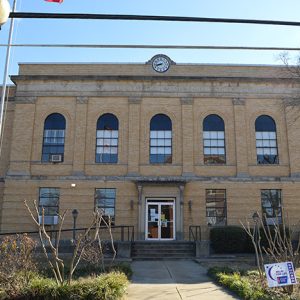calsfoundation@cals.org
Logan County Courthouse, Southern District
The Logan County Courthouse for the Southern District, built in 1929, is located on the corner of 4th and Broadway in downtown Booneville (Logan County). The Arkansas Historic Preservation Program recognizes the three-story building as architecturally and historically significant as the sole local example of the Italian Renaissance Revival style. It was added to the National Register of Historic Places on March 8, 1997.
Since the establishment of Logan County, citizens in the county’s southern portion faced long routes to reach the county seat in Paris (Logan County). Those needed in court at the Logan County Courthouse in Paris or who had business with county administrations faced traveling over a mountain range that cuts the county in half. In 1901, the Arkansas General Assembly gave those in the south a chance to choose an additional county seat to serve as their seat of justice. Booneville and Magazine (Logan County) competed in the election held on February 23, 1901. Booneville emerged victorious, with 911 votes cast for its favor, against 591 for Magazine. The courthouse at Paris began serving the Northern District.
A courthouse constructed in Booneville in 1901 served as the Southern District’s seat of justice until 1928. The county then razed the building so a new courthouse could be erected on the same site. The architectural firm Haralson & Nelson designed the project in the Italian Renaissance Revival style. This architecture is not common in Arkansas municipal buildings, but other examples include the Boone County Courthouse in Harrison (Boone County), the Bradley County Courthouse in Warren (Bradley County), and the annex to the White County Courthouse in Searcy (White County). J. Kyle Fraser of Springdale (Washington and Benton counties) built the new courthouse in Booneville with a budget of $90,000. Builders laid the cornerstone on June 8, 1929, and the first session of circuit court was held on August 19, 1929.
The Italian Renaissance Revival style is restrained in this tan-colored structure, but many of those features are present, including a rusticated exterior wall on the first floor and arched windows and pilasters on the second floor. A plain-faced clock rests on top of the building. Underneath the clock is a limestone frieze with “Courthouse Southern District Logan County” inscribed in the stone. The building also includes a full basement.
Much of the historical integrity has been preserved with little change to the interior. The only significant change is the installation of acoustical-tile ceilings in the courtroom. Notable features include white terrazzo floors, wood-trimmed transoms, and an entrance vestibule. The second-floor courtroom has wooden benches for the spectators, a paneled jury’s box, a dark lacquer judge’s bench, white plaster walls, and oak chairs for the attorneys and jurors. Most striking feature are the milk-glass chandeliers with decorative brass railings and a gold-painted fleur-de-lis at each fixture.
On the courthouse grounds, there is a Vietnam War memorial made of granite with a list of Logan County citizens lost in service.
For additional information:
Gill, John Purifoy, and Marjem Jackson Gill. On the Courthouse Square in Arkansas. N.p.: 1980.
“Logan County Courthouse, Southern District.” National Register of Historic Places nomination form. On file at Arkansas Historic Preservation Program, Little Rock, Arkansas. Online at http://www.arkansaspreservation.com/National-Register-Listings/PDF/LO0003.nr.pdf (accessed November 16, 2020).
Jared Craig
Arkansas Historic Preservation Program
 Early Twentieth Century, 1901 through 1940
Early Twentieth Century, 1901 through 1940 Historic Preservation
Historic Preservation Logan County Courthouse, Southern District
Logan County Courthouse, Southern District 




Comments
No comments on this entry yet.